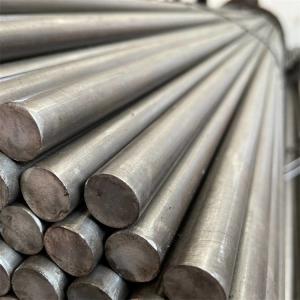

Add to Cart
H13 is widely used for aluminum and zinc casting dies, as well as for aluminum extrusion, aluminum die casting and press tooling. This grade is ideal for a range of hot work and cold work applications—particularly hot work applications where drastic cooling is required throughout its operation.
For hot work applications, H13 is used in the hardness range of HRC 38 to 48. The usual hardness range for die casting dies is HRC 44 to 48 requiring a temper at approximately 1100°F. For improved shock resistance, the steel is often tempered at temperatures approaching 1150°F, resulting in hardnesses of HRC 40 to 44.
Supply Form & Size
| Form of Supply | Size(mm) | Length(mm) |
| Round bar | 6.0mm-500mm | 2.5m-10m |
Chemical Composition&Related Specifications
| Grade | C | Mn | Cr | Mo | V | P | S | Si |
| H13 | 0.32~0.45 | 0.2-0.50 | 4.75~5.50 | 1.10~1.75 | 0.8~1.2 | ≤0.030 | ≤0.030 | 0.8~1.2 |
Brand comparison table
| AISI/SAE | DIN/EN | BS | JIS/KS | China |
| H13 | X40CrMoV5-1 | X40CrMoV5-1 | SKD61 | 4Cr5MoSiV1 |
4) Mechanical Properties - Mechanical Property
1. Pre-heat treatment The H13 steel steel and die blank supplied on
the market have been annealed heat treatment in the steel mill to
ensure good metallographic structure, appropriate hardness, good
processability, and no need for annealing. However, after the
manufacturer carried out the forging, the original structure and
properties were destroyed, which increased the forging stress, and
had to be reannealed.
The isothermal spheroidization annealing process is: 860~890 °C
heating and insulation for 2h, cooling to 740~760 °C isothermal 4h,
furnace cooling to about 500 °C out of the oven.
2. Quenching and tempering Mold quenching process specifications
requiring good toughness: heating temperature 1020~1050 °C, oil
cooling or air cooling, hardness 54~58HRC; It requires hot hardness
based mold quenching process specifications, heating temperature
1050~1080 °C, oil cooling, hardness 56~58HRC.
Recommended tempering temperature: 530~560°C, hardness 48~52HRC;
Tempering temperature 560~580°C; Hardness 47~49HRC.
Tempering should be performed twice. When tempering at 500 °C, the
tempering secondary hardening peak occurs, and the tempering
hardness is the highest, the peak is about 55HRC, but the toughness
is the worst. Therefore, the tempering process should avoid about
500 °C. According to the use of mold, tempering is better in the
range of 540~620 °C.
Quenching heating should be preheated twice (600~650 °C, 800~850
°C) to reduce the thermal stress generated by the heating process.
3. Chemical heat treatment H13 steel can further strengthen the
mold if it is gas nitriding or nitrocarburizing, but its nitriding
temperature should not be higher than the tempering temperature to
ensure that the core strength is not reduced, thereby improving the
service life of the mold.
